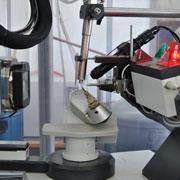Research Fields
The Amir group use organic chemistry for the synthesis of smart polymers for the formation of functional polymeric assemblies.The research focuses on design, synthesis and characterisation of the self-assembled systems and the relations between the molecular structure of the polymer and their arrangement in the assembled state. The main areas of research are:
-
Design, synthesis and characterization of delivery systems of active materials (drugs, DNA/RNA, probe molecules and pesticides) based on stimuli-responsive dendon-linear polymeric amphiphiles.
-
Development of delivery systems that can report their location and degree of activation by changing their spectral properties (NMR/MRI and fluorescence).
-
Design of polymeric building blocks for the assembly of nano structures or complex supramolecular architectures for application in nano-technology.
-
Design and development of hydrogels for 3D printing
Shmuel Carmeli studies the chemistry and biological activity of natural products isolated from marine organisms and microorganisms for almost four decades. The goals of the research are to isolated natural products for the development of antibacterial and anticancer drugs, study of the ecological fanction of these compounds and for the study of their biosynthesis.
-
Supramolecular Systems in Solution; Applications of Diffusion NMR to Supramolecular Systems (Complexation, Structure Elucidation and Hydration)
-
Hydrogen-Bond Molecular Capsules in Solution; Solution Host-Guest Chemistry
-
Synthesis and Applications of Target Specific MRI Contrast Agents
-
Applications of Diffusion MRI and MRS for Studying Brain Structure and Mechanisms of Brain Injury (Stroke, Trauma and other Neurological Disorders)
-
q-Space diffusion MRI (QSI) of the Central nervous System (CNS)
-
Double Pulsed-Field Gradient (d-PFG) NMR and MRI: From Model Systems to Imaging of the CNS: Gleaning Microstructural Information on Opaque and Neuronal Systems by d-PFG MRS and MRI
-
Cellular and Molecular MR imaging in the CNS
Development of new main group based catalysts for the activation of small molecules. Activation of small molecules has always attracted much attention in the scientific world, due to ubiquitous reservoirs of chemical energy stored in molecules such as H2, N2, O2, H2O, CH4, etc., and carbon feed stock when talking about CO2, CO etc.
Although many methods have been developed to activate small molecules involving the late transition metals or noble metals, the need for high catalyst loading in some of these processes and recovery of those precious metals results in a high economic cost. The presence of heavy transition-metal impurities in the final products also presents a major problem regarding purification, further increasing the costs involved. Therefore, developing an efficient either early transition metal based or ultimately transition-metal-free process will significantly alter the synthetic strategies toward the activation of small molecules and their delivery to the desired substrates.
The Fridman laboratory is engaged in the use of organic chemistry, especially carbohydrate chemistry, to solve key biological and medicinal problems. Our interdisciplinary studies involve the use of organic chemistry, microbiology, cell biology, molecular biology, and confocal microscopy to study and/or alter the mode of action of biologically active molecules with the focus on novel approaches for the development of antimicrobial and antitumor agents. Our current research covers four major topics: I) rational design of membrane targeting antibiotics, II) development of chemoenzymatic and chemical approaches to circumvent the action of certain resistance mechanisms to aminoglycoside antibiotics, II) structure-function studies and rational design of novel antitumor agents, and IV) exploration of bacterial biofilm matrix assembly and strategies for its formation inhibition.
My group’s research activity mainly focused on preparation and characterization of novel nitrogen-rich materials for fire-extinguishing and other applications, preparation of new materials for therapy and biomedical imaging and development of new chemosensors for forensic and other applications.
-
Design, synthesis and characterization of nitrogen-rich materials
-
Design, synthesis and evaluation of chemosensors for forensic and other applications
-
Design and synthesis of nano-materials for therapy and biomedical imaging
Our research focuses on combining rational design and synthetic chemistry to probe challenges in biology and medicine. Our projects involve modern (bio)organic syntheses, such as solid-phase synthesis, bioconjugation, combinatorial chemistry, and total chemical protein synthesis. Our research projects include the following:
-
Development of new methods for the synthesis of therapeutic peptides and proteins
-
Design and synthesis of bioactive macromolecules to inhibit oncogene expression
-
Understanding the impact of posttranslational modifications on oncogene expression
-
Building artificial nucleic acid binding proteins
-
Refining the delivery of bioactive macromolecules
The research group of Moshe Kol is investigating the synthesis of chelalting ligands and their wrapping tendencies around main-group metals and transition metals to give well-defined complexes. These complexes are investigated mostly in catalysis of stereoselective transformations with emphasis on polymerization reactions. The current research directions include:
-
Development of catalysts based on group 4 transition metal complexes for stereoselective polymerization of propylene and other alpha-olefins
-
Development of various metallic catalysts for stereoselective ring-opening polymerization of lactones, to give environmentally-benign polymers such as poly(lactic acid)
-
Design of “chiral-at-metal” complexes for asymmetric catalysis
-
Investigation of polymeryl migration processes in stereoselective polymerization reactions
-
Investigation of self-organization processes of “chiral-at-metal” complexes
Our research encompasses various aspects of synthetic organic chemistry. Among other subjects these include:
-
Solid-phase organic synthesis
-
Polymer-supported and homogeneous organocatalysis
-
Study of chemo-, site- and enantio-selectivity of catalysts in solution and on solid support
-
Synthesis of functional dendritic molecules and their applications in chemistry and biomedicine
Self-immolative dendrimers are unique structural molecules that can release all of their tail units, through a domino-like chain fragmentation, which is initiated by a single cleavage at the dendrimer's core. Incorporation of drug molecules as the tail units and an enzyme substrate as the trigger, can generate a multi-prodrug unit that is activated with a single enzymatic cleavage. Dendritic prodrugs, activated through a single catalytic reaction by a specific enzyme, were shown to present significant advantages in the inhibition of tumor growth, especially if the targeted or secreted enzyme exists at relatively low levels in the malignant tissue. Self-immolative dendrimers were also applied as a general platform for biosensor molecules, which are used to detect/amplify enzymatic activity.
Smart polymers are special kinds of polymeric molecules that respond to external stimuli. We have developed a novel smart polymer designed to sequentially disassemble into its building blocks upon initiation by a triggering event at the polymer head. The polymer structure is based on a polycarbamate backbone that disassembles through a domino-like, 1,6-elimination and decarboxylation reactions. To demonstrate the concept, we synthesized a self-immolative polymer that amplifies a single cleavage reaction into multiple-release of fluorogenic molecules and confirmed the head to tail disassembly concept. These polymers can be used to prepare highly sensitive molecular sensors with large signal-to-noise ratios. The sensors should be useful for the detection of a wide range of biological and chemical activities through use of the appropriate trigger at the polymer-head.
-
Organometallic chemistry: late transition metals, nucleophilic and electrophilic fluorination reactions
-
Supramolecular chemistry: metal complexes with new calixarene ligands, polymeric chemosensors
-
Green chemistry: organic synthesis in water and “on water”




